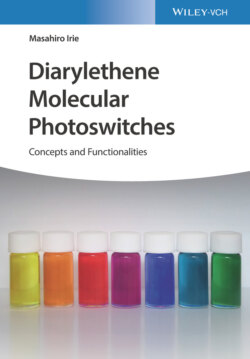Читать книгу Diarylethene Molecular Photoswitches - Masahiro Irie - Страница 15
2.2 Theoretical Study
ОглавлениеThe well‐studied photoinduced cyclization and cycloreversion reactions between 1,3,5‐hexatriene (HT) and cyclohexadiene (CHD) provide a useful framework for understanding the basic reaction mechanism of diarylethenes. As the first step, potential energy surfaces of a model diarylethene, 1,2‐bis(cyclopenta‐1,3‐dien‐2‐yl)‐ethene, were calculated using a complete active space self‐consistent field (CASSCF) method [3]. Figure 2.5 shows S0 and S1 potential energy surfaces along the reaction coordinate. On both S0 and S1 surfaces there exist two minima, a closed‐ring isomer (CHD and CHD*) and an open‐ring isomer (HT and HT*). Transition structures (TS0 and TS1) were also characterized on each potential energy surface. Several conical intersection minima (indicated by crosses) exist on both closed‐ and open‐ring sides of the potential surface in addition to CI3. CI3 is the most important conical intersection, because it is the only one that provides a pathway toward both open and closed minima on the ground state. At the conical intersection geometry, one has a triangular arrangement between three unpaired electrons belonging to carbon atoms in the two 5‐membered rings. These three electrons are weakly coupled π‐electrons, and a fourth (belonging to a three‐electron allyl fragment) is an uncoupled spectator. It is worth noting that the TS1 barrier does not exist in the CHD/HT system. The barrier is probably due to steric constraint from the sigma‐bond framework.
Figure 2.5 Potential energy surfaces of a model diarylethene.
Source: Reprinted with permission from Ref. [3]. Copyright 2003 American Chemical Society.
Figure 2.5 shows the potential energy surfaces along the reaction coordinate of the hydrocarbon model system. A more realistic model is dithienylethene. The potential energy surfaces of 1,2‐di(3‐thienyl)ethene (12) were calculated as a function of the distance between two reactive carbon atoms, R(C—C), using the CASSCF method, as shown in Figure 2.6 [4]. To understand the reaction mechanism, a molecular mechanics‐valence bond (MMVB) computation of the dynamics was also carried out. Three‐dimensional representation of the structures of S0 and S1 potential energy surfaces and two‐dimensional simplified one of the structures are shown in Figures 2.7 and 2.8, respectively [5]. These figures also outline minimum energy paths corresponding to ring‐closing and ring‐opening reactions of the dithienylethene.
Figure 2.6 Potential energy surfaces of ground (1A) and two excited (2A and 1B) states of 12 as a function of the distance between two reactive carbon atoms.
Source: Reprinted with permission from Ref. [4]. Copyright 2004 American Chemical Society.
Figure 2.7 Schematic representation of the structures of S0 (orange) and S1 (green) potential energy surfaces corresponding to the photoisomerization between open‐ and closed‐ring isomers of a diarylethene. Reaction coordinate is the distance between the two reactive carbon atoms.
Source: Adapted from Ref. [5] with permission from the PCCP Owner Societies.
Figure 2.8 Outline of two reaction paths corresponding to ring‐opening and ring‐closing reactions of a diarylethene. The letters in parentheses, c and o, represent closed‐ and open‐ring isomer structures, respectively.
Source: Reprinted with permission from Ref. [6]. Copyright 2014 American Chemical Society.
Upon irradiation with UV light, the open‐ring isomer is excited to the allowed Frank–Condon state (1BFC(o)), which is close in energy to a 2A surface, and fast internal conversion to the 2A state takes place. The excited wavepacket moves down along the 2A surface and the conical intersection (2A/1ACI(o)) can then be accessed via vibrations orthogonal to the reaction pass, as shown in Figure 2.7. At the conical intersection, efficient decay to the ground state potential energy surface takes place, leading to the formation of the closed‐ring isomer. This mechanism accounts for the highly efficient and ultrafast ring‐closing reaction.
The ring‐opening reaction takes place as follows. Upon irradiation with visible light, the closed‐ring isomer is excited to the allowed 1B Frank–Condon state (1BFC(c)). The excited wavepacket moves away from the Frank–Condon region along the 1B surface and rapidly falls from the 1B to 2A surface via a conical intersection (1B/2ACI(c)). The molecule excited with light of shorter wavelengths having vibrational excess energy on the 2A surface goes over the energy barrier 2ATS1 more readily and reaches 2A/1A conical intersection (2A/1ACI(o)). The conical intersection is reached via vibrations orthogonal to the initial motion in the valley. At the conical intersection, fast deactivation to the ground state takes place and thus the open‐ring isomer is formed. The route suggests that thermal activation or excess kinetic energy on the 2A surface is required for the ring‐opening reaction to take place. This agrees with experimental observation that the ring‐opening reaction has an activation energy and that the quantum yield increases upon irradiation with light of shorter wavelengths (see Section 3.1.3) [7, 8].
